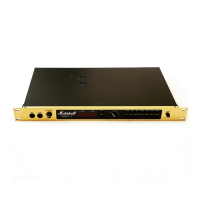ENGLISH
CRUNCH GREEN MODE: This mode shares
the preamp topology of the classic Mar-
shall JTM45/1959 Plexi™ models
(i.e.: gain + gain + tone) but with a bit more
gain than is found in the originals.
CRUNCH ORANGE MODE: This mode is
reminiscent of the JCM800 2203 amplier,
a staple of hard rock. The gain structure is
gain + gain + gain + tone.
CRUNCH RED MODE: This shares the topology
of the orange mode, but with more gain,
giving you sounds similar to a hot-rodded
JCM800.
4. OD1 CHANNEL
OD1 GREEN MODE: This is very similar to
the hot-rodded JCM800 sound found in
crunch red mode, allowing you to dial-in
two disnctly dierent yet similar crunch
sounds if you so wish - one in each channel.
OD1 ORANGE MODE: This adds another gain
stage to the OD1 green mode, resulng in
a sound that’s perfect for singing leads and
hard rock/heavy metal tones.
OD1 RED MODE: Adds more gain to the OD1
orange for a high gain Marshall sound.
5. OD2 CHANNEL
This channel is similar to the OD1 channel
but with even more gain and a slightly
dierent tone network with the middle
control shied down to being centred
around 500hz instead of the more typical
Marshall value of 650hz. The result is 3
high gain modes that are ideal for both lead
and modern rhythm metal tones.
MASTER SECTION
6. REVERB
Pressing the REVERB buon switches the
reverb ON and OFF in the current channel.
Each channel has its own reverb control
allowing individual channel reverb level
sengs: RVB CLEAN, RVB CRUNCH, RVB
OD1 and RVB OD2.
7. MASTER 1 / MASTER 2
These are the master volume controls
of the amplier. They can be assigned
individually to each of the modes as you
wish and their seng will be remembered.
8. PRESENCE AND RESONANCE
These controls are power-stage funcons
and only have eect when playing through
a speaker (not in SILENT RECORDING).
They aect how the power amplier reacts
to the connected speakers and how much
control the amplier has over them.
Increasing the RESONANCE control
emphasises speaker resonance for an
improved bass response and lower-end
thud. In the same way, increasing the
PRESENCE control emphasises the
speaker’s higher frequencies, making the
sound brighter and more ‘present’.
PRESENCE and RESONANCE constute
a powerful power-stage EQ, allowing
responses from a ‘
’ shape when they are
fully o, which is felt as a mid-boost, to a
‘v’ shape when they are turned clockwise,
giving a more scooped sound. Again, the
eecveness of these controls is highly
dependent on the kind of connected
speakers. Care has to be taken to avoid
over excursion of the speaker cones in high
resonance sengs.
9. FX LOOP
Pressing the FX LOOP buon switches
the FX loop ON and OFF in the current
channel.
The FX loop is programmable and features
a MIX control on the rear panel. The FX
FRONT PANEL FUNCTIONS (CONT.)

